Sterlitamak
Sterlitamak (Russian: Стерлитамак, IPA: [stʲɪrlʲɪtɐˈmak]; Bashkir: Стәрлетамаҡ; Bashkir pronunciation: [stær.ˌlɪ̞.tɑ.ˈmɑq]![]()
Sterlitamak Стерлитамак | |
|---|---|
City[1] | |
| Other transcription(s) | |
| • Bashkir | Стәрлетамаҡ |
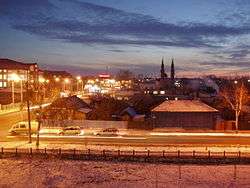 View of Sterlitamak | |
 Flag .png) Coat of arms | |
Location of Sterlitamak 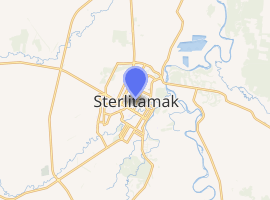
| |
 Sterlitamak Location of Sterlitamak 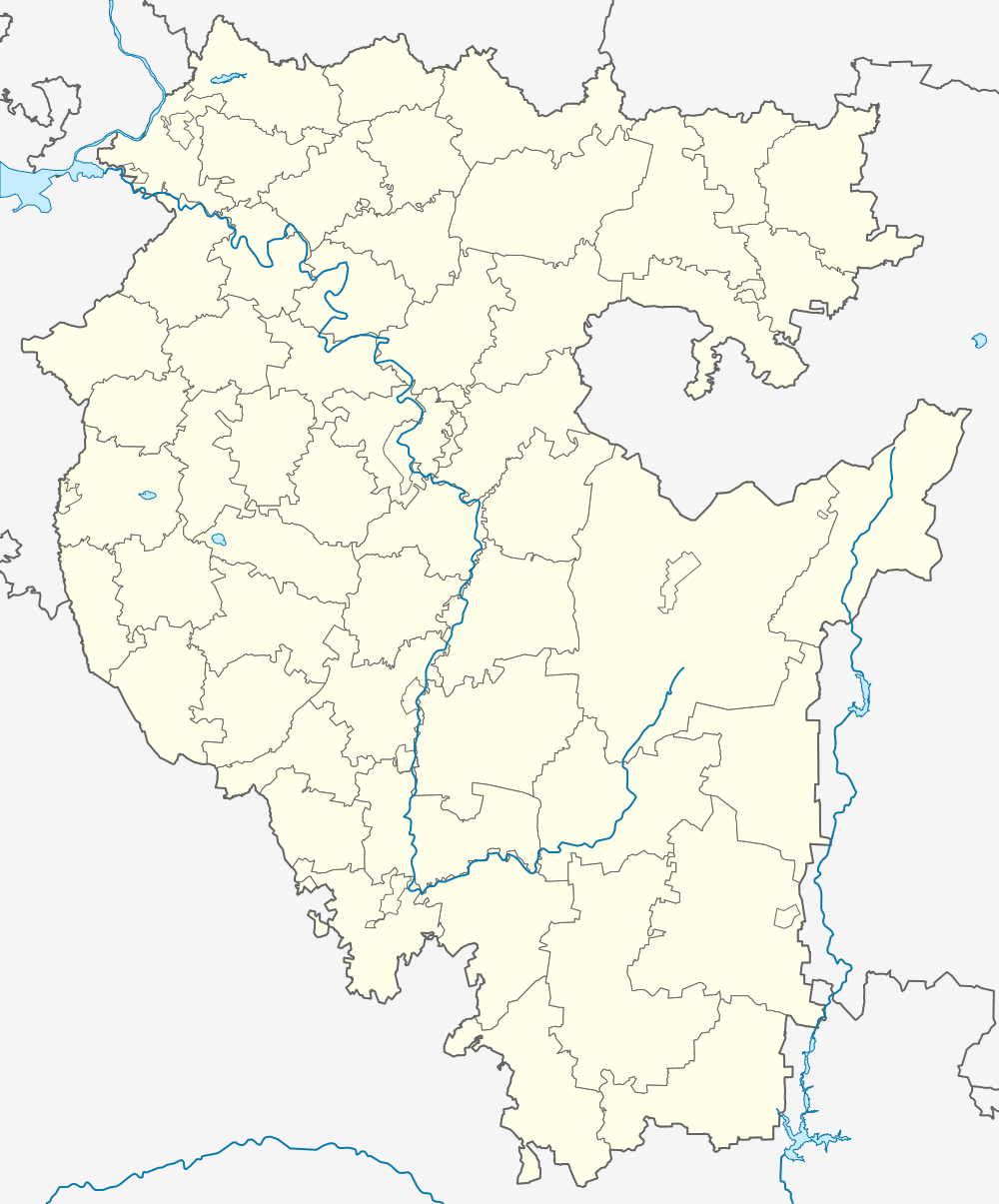 Sterlitamak Sterlitamak (Bashkortostan) | |
| Coordinates: 53°38′N 55°57′E | |
| Country | Russia |
| Federal subject | Bashkortostan[1] |
| Founded | 1766 |
| City status since | 1781 |
| Government | |
| • Body | Council[2] |
| • Head | Vladimir Kulikov (since 2016)[3][4] |
| Elevation | 150 m (490 ft) |
| Population | |
| • Total | 273,486 |
| • Estimate (2018)[6] | 279,626 (+2.2%) |
| • Rank | 66th in 2010 |
| • Subordinated to | city of republic significance of Sterlitamak[1] |
| • Capital of | city of republic significance of Sterlitamak[1], Sterlitamaksky District[7] |
| • Urban okrug | Sterlitamak Urban Okrug[8] |
| • Capital of | Sterlitamak Urban Okrug[8], Sterlitamaksky Municipal District[8] |
| Time zone | UTC+5 (MSK+2 |
| Postal code(s)[10] | 453100 |
| Dialing code(s) | +7 3473 |
| OKTMO ID | 80745000001 |
| Website | sterlitamakadm |
Geography
Sterlitamak is located just south of the geographical center of the Republic of Bashkortostan, 121 kilometers (75 mi) from Ufa. Approximately 50 kilometers (31 mi) to the east of the city are the Ural Mountains; to the west the East European Plain begins. In the vicinity of Sterlitamak (inside the Belaya basin) are the Shikhan Mountains (Yurak Tau, Kush Tau, Shakh Tau, and Tra Tau), which are unique geological formations. In the area of Mount Kush Tau, there are children summer camps and "Shikhany" sanatorium; there is also a ski base on the slope of the mountain.
Originally the town was built in the area between the Ashkadar and Sterlya Rivers. This area is now considered the historical center and is known as the "Old Town". Subsequently, Sterlitamak was built mainly to the west and north.
The Sterlya, which falls into the Ashkadar River to the east, flows through the central part of the city. One train bridge and four regular bridges cross the Sterlya, and another one is under construction. In the southeastern part, the Ashkadar separates Zaashkadarye Microdistrict from the main part of the city. Also, in the east Sterlitamak borders with the Belaya River, which forms the boundary between Sterlitamaksky and Ishimbaysky Districts. In the south, near the heavy machinery factory, the city is bordered by the Olkhovka River, which is also an influx of the Ashkadar.
History
At the beginning of the 18th century a post house ("Holes") was situated on the Ufa-Orenburg road where Sterlitamak now stands. A merchant, Savva Tetushev, by the decree of the Empress Catherine the Great, founded a marina on the river Ashkadar, which after the merger with the post office became known as the "Sterlitamak salt pier".
Sterlitamak was founded in 1766 as a port for the distribution of salt mined up the river. During Pugachev's Rebellion of 1773-1775, Sterlitamak was under the control of insurgents, and was subsequently burned. After the restoration, it became the administrative center of Sterlitamaksky Uyezd, and was subsequently granted town status in 1781.
The city grew rapidly during industrialization in the late 19th century. At the time, local landowners established beer brewing, vodka distilling, and leather working industries.
Prior to the abolition of serfdom, the most influential landowners of Sterlitamaksky Uyezd were the Levashovs (from the village of Levashovka, now a part of the city), the Mikhaylovs (from the village of Mikhaylovka; now Mikhaylovka Microdistrict), the Belousovs (from Belousovo, merged into the city in 2001). In the town, there were private companies and a variety of handicraft industries (leather and leather products, flour mill, the production of vodka and beer). Major employers of the city were Usmanov, Bayazitov, and Utyamyshev. After the abolition of serfdom, the city grew significantly in numbers and territory; there were large-scale production enterprises. In 1870, the building of Sterlitamak City Duma was constructed.
After the February Revolution, Sterlitamak Council nationalized banks, the telegraph, and the main industrial enterprises in the city. By the decree of the Central Executive Committee on March 23, 1919, Bashkir Autonomous Soviet Socialist Republic (BASSR) was proclaimed, and Sterlitamak became the capital of the autonomy. Later, in 1922, the capital was moved to Ufa as the Soviet government began transforming the town into an industrial center.
Before World War II, Sterlitamak was growing rapidly, mainly due to consolidation of enterprises and the construction of new ones. In 1922, the first power plant was launched, supplying the mills and sawmills with energy. A leather sheepskin factory and sawmill were merged into one large sawmill.
In 1930, Sterlitamaksky District was created (at that time 24,000 people lived in Sterlitamak), and oil started to be extracted in 1932 on its territory. Two towns were established in the vicinity of Sterlitamak to tend to the oil fields—Ishimbay 21 kilometers (13 mi) southeast and Salavat 26 kilometers (16 mi) to the south. At the same time, the railway was laid at Sterlitamak (mainly for freight), and in 1934 the first freight train arrived. In connection with all these changes, the population of the town prior to 1939 increased by 58% and reached 37,900 people.
During the Great Patriotic War, many industries were evacuated to Sterlitamak: soda and cement factories, the "Red Proletarian" factory, Lenin Machine-Tool Plant, Moscow Shoe Factory, and Voronezh State Drama Theater.
In 1960, a telephone relay station was built in Sterlitamak.
The first trolleybus line in BASSR was put into operation in Sterlitamak in 1961. The main reason for this decision was a bad environmental situation in the 1980s. Thus, by the end of 1980, Sterlitamak had appeared in the list of the most polluted cities in the country because of the amount of harmful emissions.
Due to the sharp rise in employment capacity in the city, it was decided to extend the city further to the east, to the Belaya River, and to construct bypass roads for freight transport from the west between Sterlitamak and Salavat. By 1984, the population had reached 237,900.
Administrative and municipal status
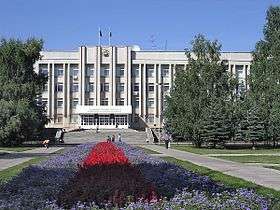
Within the framework of the administrative divisions, Sterlitamak serves as the administrative center of Sterlitamaksky District,[7] even though it is not a part of it.[1] As an administrative division, it is incorporated separately as the city of republic significance of Sterlitamak—an administrative unit with the status equal to that of the districts.[1] As a municipal division, the city of republic significance of Sterlitamak is incorporated as Sterlitamak Urban Okrug.[8]
Economy
The city is linked by rail to Ufa and Orenburg. There is also a small local airport located 30 kilometers (19 mi) from the city.
Sterlitamak is a developed industrial city with complete infrastructure and good transport system.
Construction in the city is moving fast to develop new microdistricts (Yugo-Zapadny and VTS). New buildings are erected in the western quarter of the city, including Solnechny, Lazurny, and Zapadny Microdistricts.
Sterlitamak is a large center of chemical industry (Sterlitamak Petrochemical Plant, Bashkir Soda Company) and mechanical engineering (Sterlitamak Machine Tool Works).
The city has plants producing vodka (subsidiary Bashspirt) and beer (Heineken).
Education
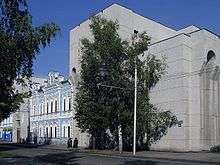
At present, there are 57 kindergartens, 35 schools, 6 high schools, 1 lyceum, 8 vocational schools, 7 colleges, SKSEiP trade school, branches Ufa State Oil Technical University, Bashkir State University, Ural State University of Physical Culture (Sterlitamakskij Physical Culture Institute), Ufa State Aviation Technical University, Modern Humanitarian Academy (WGA), Eastern Economic State University (VEGU).
Ecology
During the 1970s in connection with the bad environment in the city, there were projects to make the city greener. There was even a program in which each student had to plant a tree, and according to former Mayor Spartak Akhmetov, the child who planted a tree in his childhood, will feel responsibility to the problems of pollution of his native city. As a result, by 2007 the number of traditional Russian birch trees increased by 350% and surpassed even Samara that has a million population.
In 1987, the Council of Ministers of the USSR passed a decision to improve the ecological situation in the city. Currently, there are many gardening and landscaping programs in Sterlitamak, republican and municipal budgets has allocated the necessary funds to accomplish these objectives, attracting more and more people into landscaping and improvement of the city.
Both Bashkotrostan and Sterlitamak have implemented a federal program for renovating housing and communal services. In the city it operates since 2008, but few buildings has actually been renovated with balconies, new tile roofs, with streamlined elevators, new sewers and repaired doors.
One result of landscaping and improvement programs is the title of "Golden City of Russia" received by Sterlitamak. In 2007 the city was awarded the title of "the most comfortable city in Russia," among cities with populations up to a million people. Just 15 years Sterlitamak from the list of the most polluted cities joined the list of the cleanest and greenest cities in Russia. One reason for the sharp improvement in the environment and livability was a unique strategy for the city administration on key industries — each of the seventeen largest plants were "attached" area of the city, which they must serve. Another reasons were the campaign for cleanliness in the streets, the mentality of the residents, high sense of responsibility of city utility services.
In addition to the honorary title of "Golden City of Russia", in 2009, the municipal service of park management of Sterlitamak took the first place "Crystal Wheel 2009" among the city parks of Russia and CIS countries under the nomination of "Best Amusement Park with the number of visitors from 100 thousand to 250 thousand people per year".
For more than five years, this competition is being held in Sochi, in order to identify and disseminate the best of positive experiences in different areas of park operations and high service quality standards in the field of recreation and family entertainment. Its geography is quite wide: compete park management from Moscow, Krasnodar, Almetyevsk, Sterlitamak, Mytishchi, Tyumen, as well as the cities of CIS countries. This year, the competition was supported by the Ministry of Culture of Russia and has grown to even more significant scale. In Sterlitamak the merger of all city parks into one municipal enterprise has significantly improved their logistical base, diversify the attractions and make them really popular place where the townspeople.
Miscellaneous
The city has twelve hospitals accounting for 2,700 hospital beds and eighteen outpatient clinics.
Of the major sports facilities in Sterlitamak currently operate 3 stadiums (a sports stadium, stadium Sodovik "stadium" Sportakademiya "), 2 swimming pools (with a length of track, 25 meters).
In the city there also are: Sterlitamak Historical Museum, Art Gallery of Bashkir State Art Museum MV Nesterova, "Theatrical Association, the Sterlitamak"(which includes: the State Russian Drama Theater, Bashkir Drama Theater, Dance Theater), Theater-studio "Benefis" City Philharmonic. There are 3 cinemas ( "Iskra", cinema "Salavat" with 2 cinema halls, a children's "Pioneer"), 5 palaces and houses of culture, the Palace of Pioneers and schoolchildren named after AP Gaidar. The city has one TV broadcast and one radio channel.
By 2007, the city acted in a professional football club "Sodovik", took part in the First Division Championship of Russia on football. Unfortunately, funding was discontinued after a change of management in Soda Company (sponsored by PFC "Sodovik"). The new management of the company has found the funding of the football club unprofitable. By early 2008, a children's football school was shut down as part of the elimination of the organization PFC "Sodovik". Around 300 boys from 8 to 18 dropped out from the football club (details at the club).
Meteorite
Near midnight on May 17, 1990, a meteorite fell into a field 20 km west of Sterlitamak and made a crater about 10 m in size and 5 m in depth with surrounding ejecta. Several fragments up to 6 kg were found in and near the crater. One year later the thumbprinted main mass of 315 kg was found when digging out the crater. The meteorite is made of iron of the octahedrite (IIIAB) type. The main mass is now in the Museum of Archaeology and Ethnography, Ufa Scientific Center, the Russian Academy of Science.
Demographics
| Year | Population |
|---|---|
| 1939 | 38,800 |
| 1959 | 111,000 |
| 1970 | 184,000 |
| 1989 Census[12] | 247,457 |
| 2002 Census[13] | 264,362 |
| 2008 | 268,300 |
| 2009 | 269,700 |
| 2010 Census[5] | 273,486 |
Transportation
Roads
The main streets of the city include:
- Lenina Avenue - from Ufa road to Eternal Flame
- Khudayberdina Street - from [Rajewski] tract (Bus Station) to the river Ashkadar
- Mira Street - connects VTS microdistrict to the city center
- Kommunisticheskaya Street, Artyoma Street, Oktyabrsky Avenue - link Yugo-Zapadny, Solnechny, and Bolnichny Microdistricts to the city center
From the west, bends around the city a bypass road, allowing transit vehicles, traveling at highway Ufa - Orenburg, bypass Sterlitamak and Salavat.
Public transport
Trolleybus
The main public transport mode in Sterlitamak is the trolleybus. The trolleybus system has 18 main and 3 supplementary routes, served by 135 trolleybuses each day. It carries more than 230,000 passengers per day, representing about 80% of public transport usage in Sterlitamak. It has become a tradition for Sterlitamak to extend trolleybus routes to serve new construction sites, and this explains the great popularity of the trolleybus in the city.
Most trolleys have been purchased from "Bashkir Trolleybus Plant".
Bus
Also in the city has a bus service. Major bus routes pass through the main streets of the city and most of them repeat trolleybus routes, but are inferior in frequency to trolleys. Bus transportation is provided by Sterlitamak Passenger Motor Transportation Enterprise (GUP Bashavtotrans). These are comfortable buses, with a lowered stance, a Bashkir brand NEFAZ.
Other types of public transport
Also, the city has shuttle buses, which exceed the bus and trolley buses in speed and maneuverability (they are substantial due to the increase of traffic jams in the city). On July 25, 2008 in the city it became forbidden to use Gazelle minibuses, a step because the engines of national Gazelles are not equipped with environmental standards Euro-3, so now there are Mercedes Sprinter, Volkswagen Transporter and Peugeot Boxer minibuses in operation. All these foreign brands are equipped with engines of Euro-3 and EURO-4, and have a high level of security. In the spring of 2009 the city administration gave permission for passengers on the "Gazelle", provided that their number does not exceed 40 units.
Intercity
Railway
The city has a station on the segment of non-electrified route "Ufa-Orenburg", but is out of demand from the passengers and is used mainly for cargo transportation. The main disadvantage of rail transport in this direction - a very low speed (the road to Ufa will take approximately 5 hours, for buses - 2,5–3 hours). This is because the main part of the road passes through the single track road.
Industry
The economic potential of cities largely determined by few major chemical and petrochemical enterprises. B 2008 they produced goods worth 37 billion 340 mln. rubles Soda company in 2008, has shipped products worth 13 billion 788 million rubles. Caustic Inc. has shipped products amounting to 10 billion 344 million rubles.
Sterlitamak Petrochemical Plant has shipped to consumers goods with total cost of 3 billion 868 million rubles. SNHZ remains Russia's only supplier of phenolic antioxidants for rubber production, continued development of the production stabilizers series Agidol. Tough times were upon JSC "Rubber", "Synthesis-Rubber" and "Vanguard".
Engineering and machine tool industries in the city are represented by: Sterlitamak Machine-tool Plant", Red Proletarian, Car-Repair Plant, Plant Stroymash, and Inmash. In addition, there are few building enterprises in the city. Sodovik the first time in the past 14 years managed to reach the volume of cement production over 1 million tons. Work construction companies, the largest one of them - JSC Trest Sterlitamakstroy. There is also developed food industry. Production Plant Stalk (alcohol-vodka production) and a brewery Shihan (until 2005) known and popular not only in the republic, but in many neighboring regions of Russia, Sterlitamakskij Bakery, celebrated in 2009, 100 years also widely known not only the country but also around the Volga region, in the city there are also two large dairy factories, more four sausage factories.
The industrial enterprises in 2008 have shipped to consumers more than 51,6 billion rubles worth of produce.
Notable people
- Aleksandra Soldatova, rhythmic gymnast
External links
- Official website of Sterlitamak (in Russian)
- Official website of the Council of Sterlitamak(in Russian)
- Photos of old Sterlitamak
References
Notes
- Resolution #391
- Council′s official website
- The decision on the appointment of the head of administration
- Russian Federal State Statistics Service (2011). "Всероссийская перепись населения 2010 года. Том 1" [2010 All-Russian Population Census, vol. 1]. Всероссийская перепись населения 2010 года [2010 All-Russia Population Census] (in Russian). Federal State Statistics Service.
- "26. Численность постоянного населения Российской Федерации по муниципальным образованиям на 1 января 2018 года". Federal State Statistics Service. Retrieved January 23, 2019.
- Государственный комитет Российской Федерации по статистике. Комитет Российской Федерации по стандартизации, метрологии и сертификации. №ОК 019-95 1 января 1997 г. «Общероссийский классификатор объектов административно-территориального деления. Код 80 249», в ред. изменения №278/2015 от 1 января 2016 г.. (State Statistics Committee of the Russian Federation. Committee of the Russian Federation on Standardization, Metrology, and Certification. #OK 019-95 January 1, 1997 Russian Classification of Objects of Administrative Division (OKATO). Code 80 249, as amended by the Amendment #278/2015 of January 1, 2016. ).
- Law #162-z
- "Об исчислении времени". Официальный интернет-портал правовой информации (in Russian). June 3, 2011. Retrieved January 19, 2019.
- Почта России. Информационно-вычислительный центр ОАСУ РПО. (Russian Post). Поиск объектов почтовой связи (Postal Objects Search) (in Russian)
- Bobrov, Aleksandr (2009). Золотой берёзовый листок. Sovetskaya Rossiya Archived September 24, 2015, at the Wayback Machine (in Russian)
- "Всесоюзная перепись населения 1989 г. Численность наличного населения союзных и автономных республик, автономных областей и округов, краёв, областей, районов, городских поселений и сёл-райцентров" [All Union Population Census of 1989: Present Population of Union and Autonomous Republics, Autonomous Oblasts and Okrugs, Krais, Oblasts, Districts, Urban Settlements, and Villages Serving as District Administrative Centers]. Всесоюзная перепись населения 1989 года [All-Union Population Census of 1989] (in Russian). Институт демографии Национального исследовательского университета: Высшая школа экономики [Institute of Demography at the National Research University: Higher School of Economics]. 1989 – via Demoscope Weekly.
- Russian Federal State Statistics Service (May 21, 2004). "Численность населения России, субъектов Российской Федерации в составе федеральных округов, районов, городских поселений, сельских населённых пунктов – районных центров и сельских населённых пунктов с населением 3 тысячи и более человек" [Population of Russia, Its Federal Districts, Federal Subjects, Districts, Urban Localities, Rural Localities—Administrative Centers, and Rural Localities with Population of Over 3,000] (XLS). Всероссийская перепись населения 2002 года [All-Russia Population Census of 2002] (in Russian).
- Итоги Всероссийской переписи населения по Республике Башкортостан (in Russian). Территориальный орган Федеральной службы государственной статистики по Республике Башкортостан. Archived from the original (pdf) on March 9, 2013. Retrieved March 5, 2013.
Sources
- Правительство Республики Башкортостан. Постановление №391 от 29 декабря 2006 г. «Об утверждении реестра административно-территориальных единиц и населённых пунктов Республики Башкортостан», в ред. Постановления №61 от 26 февраля 2013 г. «О внесении изменений в реестр административно-территориальных единиц и населённых пунктов Республики Башкортостан». Опубликован: "Ведомости Государственного Собрания – Курултая, Президента и Правительства Республики Башкортостан", №5 (251), ст. 239, 12 марта 2007 г. (Government of the Republic of Bashkortostan. Resolution #391 of December 29, 2006 On Adoption of the Registry of the Administrative-Territorial Entities and Inhabited Localities of the Republic of Bashkortostan, as amended by the Resolution #61 of February 26, 2013 On Amending the Registry of the Administrative-Territorial Entities and Inhabited Localities of the Republic of Bashkortostan. ).
- Государственное Собрание —Курултай Республики Башкортостан. Закон №162-з от 17 декабря 2004 г. «О границах, статусе и административных центрах муниципальных образований в Республике Башкортостан», в ред. Закона №572-з от 17 июля 2012 г. «О внесении изменения в статью 2 Закона Республики Башкортостан "О границах, статусе и административных центрах муниципальных образований в Республике Башкортостан"». Вступил в силу в соответствии со статьёй 33. Опубликован: "Республика Башкортостан", №52 (25785), 22 марта 2005 г. (State Assembly of Bashkortostan—El Kurultai. Law #162-z of December 17, 2004 On the Borders, Status, and Administrative Centers of the Municipal Formations in the Republic of Bashkortostan, as amended by the Law #572-z of July 17, 2012 On Amending Article 2 of the Law of the Republic of Bashkortostan "On the Borders, Status, and Administrative Centers of the Municipal Formations in the Republic of Bashkortostan". Effective as of the date established in accordance with the provisions of Article 33.).